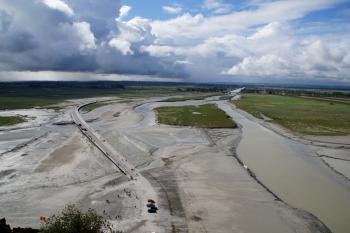
Even though I had seen many photos of Mont-Saint-Michel, it was a real wow-effect when I saw this pyramid for the first time. The Mont and the striking shape of the abbey are already visible from a distance, towering above the green meadows. It must have been even more awe-inspiring for the people in the Middle Ages. So it's no wonder that Mont Saint-Michel was a strategically important monastery and a famous pilgrimage site. A legend goes that Bishop Aubert had a dream in which the Archangel Michael asked him to build a church on top of the island. Initially, Aubert did not follow the order. The archangel had to appear to him again, piercing a hole in the bishop's skull with his finger. A relief in the abbey depicts this scene. Fortunately, the bishop finally obeyed, so France has another top tourist destination and an iconic WHS.
We visited Mont Saint-Michel in August 2015. All the construction works are completed: the car park at the foot of the Mont has been removed and the new stilt bridge replaces the old causeway. The dam at the Couesnon river is in operation for a few years. The aim of this project is to flush the deposited sediments out of the bay and to increase the depth of the water around the island. So the Mont will recover its maritime character, but this will take decades. Today, the Mont is an island only at extremely high tides. Our visit was at low tide and the photo shows that not much has changed compared to Els' photo from 2013.
We arrived at the new car park at quarter to 9 pm. Free shuttle buses run from the visitor centre to the Mont, but we took the sporty alternative and walked the 3 kilometres, the last 800 metres on the new footbridge. The main road, the Grand Rue, was already quite busy when we arrived, so we went directly up to the main entrance of the abbey, passing the St Peter's church and the picturesque cemetery. The self-guided tour (9 Euro) starts at the guard room, then we climbed an external staircase to the highest point of the Mont, the Western terrace in front of the entrance to the abbey church. From the terrace you have a wonderful view over the bay and the mud flats.
The interior of the abbey is nothing special, the typical elements of a monastery, although it is surprising to find a cloister on the steep peak of a rock. Extraordinary is the layout of the complex. The rooms are arranged in a downward spiral around the rock, the way down takes you over numerous stairs through vaulted halls and crypts with massive pillars. The lower rooms support the upper parts. The history of the abbey began in the 8th century and it was rebuilt and extended in the following centuries, so it is a mixture of several architectural styles, but the result is impressive.
We took the ramparts walk for the descent to the foot of the Mont. It's more pleasant than the main road, but also lined with souvenir shops and overpriced restaurant. Were these the back doors of the restaurants on the Grand Rue or different ones? We paid no attention to their menus and left the Mont rather hungry, because we were looking forward to another highlight on that day: Cancale on the opposite side of the bay, famous for its oyster farming. Cancale is a busy and picturesque harbour, the quay is a long row of stalls and restaurants. We had a late, but delicious lunch with oysters and seafood.
We stayed at Saint Malo, which I can also recommend. Saint Malo has a nice town centre and many lovely shops, perfect to look out for souvenirs from Brittany. We finished the day with more local delicacies: Galettes and a carafe of cider.
More on
Comments
No comments yet.
